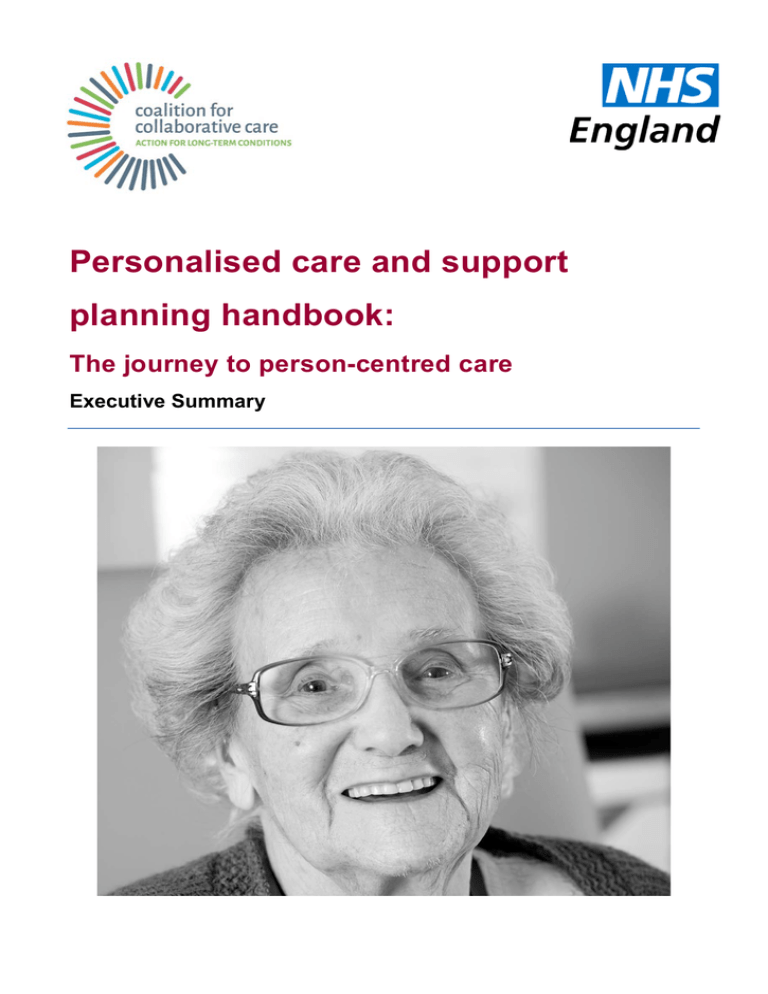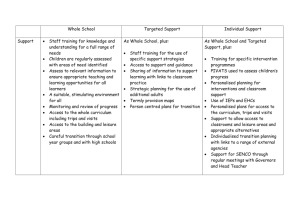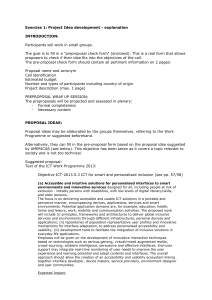Personalised care and support planning handbook: The journey to person-centred care
advertisement

Personalised care and support planning handbook: The journey to person-centred care Executive Summary Document Title: Personalised care and support planning handbook: The journey to person-centred care Subtitle: Executive Summary Version number: 0.9 First published: 7 January 2015 Updated: First Publication Prepared by: Domain Team, Person-Centred Care Team and Coalition for Collaborative Care Classification: Official 2 Purpose of this handbook The NHS Five Year Forward View, which sets out the future vision for the NHS, notes that ‘Long term conditions are now a central task of the NHS; caring for these needs requires a partnership with patients over the longer term rather providing single, unconnected “episodes” of care’. The reasons for this are set out in a recently published call for action by the Coalition for Collaborative Care: “People living with long term condition (LTCs) are the biggest users of NHS services and the largest part of the health service budget is spent on their support. The care and support needed to live well with a LTC is fundamentally different to that for acute health conditions while people with LTCs often spend just a few hours a year with health and care professionals, they live with their conditions and manage them on a daily basis themselves. The health and care system must support individuals to have the knowledge, skills and confidence to design and manage their own health and care, and to support one another in the context of their wider families and communities. We therefore need a major re-design of current approaches. This will call for many changes across the health and care system: from the way professionals and people interact in face to face consultations, to how professionals are trained and what support people can tap into, including support for carers and family members”. We are publishing this handbook to help those with key local responsibilities for the future of the health service to respond to these expectations in respect of people with long term conditions – using the approach of personalised care and support planning. What is personalised care and support planning? Personalised care and support planning is an essential gateway to better supporting people living with long term physical and mental health conditions, and carers, helping them to develop the knowledge, skills and confidence to manage their own health, care and wellbeing. It helps individuals and their health and care professionals have more productive conversations, focused on what matters most to that individual. Together they agree goals, identify support needs, prepare for the future, develop and implement action plans, and review progress. This is a planned and continuous process, not a one-off event. The term ‘personalised’ reflects that the conversation relies on equal input from the individual and their carer, where appropriate, alongside health and care practitioner(s), and looks at the individual’s health and care needs within the wider context of their lives. ‘Care and support’ signals that people need more than medicine or clinical treatments and that social, psychological needs and support to do things for themselves are equally important, alongside opportunities for community inclusion and support. The evidence and benefits There is evidence that personalised care and support planning can lead to improved outcomes. The Year of Care Programme 1 developed and tested models of personalised care planning that successfully delivered benefits to patients, clinicians and commissioners. 1 http://www.yearofcare.co.uk 3 The Cochrane Review on personalised care planning 2 found that personalised care planning plus appropriate follow-up support leads to improvements in certain indicators of physical, psychological, and subjective health status, and people’s capability to selfmanage their condition (self-efficacy). The studies showed that the effects were greater when it included preparation, record-sharing, care coordination and review, involved more intensive support from health professionals, and was integrated into routine care. The potential benefits of personalised care and support planning to individuals include: • Understanding their condition(s) or disability better • Feeling more confident and able to manage their own health and care • Playing a more active role in managing their condition and getting recognition and support from professionals in this role • Preventing a deterioration in their condition or symptoms • Tailored support to increase confidence and skills in self-management Benefits to health and care practitioners include: • More satisfying consultations • Improved monitoring of health and care • Better outcomes for people with LTCs • Less unnecessary use of medication The benefits to commissioners include: • Greater value for money, as services provided meet individual needs, deliver improved health outcomes and reduce medicine wastage • Offers a measurable assessment of an individual’s needs or goals to guide commissioning of appropriate services • A positive impact on other local and national drivers, e.g. reducing unnecessary acute admissions and improving the patient experience • Recognising the renewable energy that patients, carers and communities can bring to supporting long-term conditions care. The role for commissioners Commissioners play a key role in helping to implement personalised care and support planning. They should consider how they: • • • commission appropriate person-centred services that promote and embed personalised care and support planning. This includes developing service specifications and innovative payment and contracting methods which promote partnership and collaboration in local health populations consider which patients would benefit most from personalised care and support planning using risk stratification tools or identifying people with lower levels of health literacy or confidence commission a range of support for self-management services to supplement traditional services and to ensure a more than medicine approach e.g. structured education programmes, peer support networks, coaching 2 Coulter A, Entwistle V A, Eccles A, Ryan S, Shepperd S, Perera R. (2014) Personalised care planning for adults with chronic or long-term health conditions, Cochrane Database of Systematic Reviews 2014 [in press] 4 • • promote the development of the workforce to have the skills and competencies to work in this way, ensuring space for ongoing training, development and reflection, both for commissioners and providers ensure a robust local measurement system is in place to inform and support improvement. Delivering personalised care and support planning National Voices, in collaboration with a wide range of partners and people who use services, have developed a common understanding about what is meant by care and support planning 3. They highlight the four main steps of the care and support planning process and have identified a number of principles to help ensure that the process is truly person-centred. These principles are the basis for the guidance on delivering personalised care and support planning. 1. Prepare • Starts from the point of view of the person • Gathers necessary information and makes it available upfront • Builds in time to reflect and consider options Individuals will need time, support and information to help them prepare for a discussion about their care and support. This might include being able to view test results; having access to accessible, relevant information to aid decision making; or time to identify and discuss their preferences with family, carers, advocates or peers. Health and care practitioners will also need to prepare for care and support planning discussions. This might include liaising with other care professionals, and building a better understanding of local services and support which might benefit patients and carers in their local area. 2. Discuss • Takes a partnership approach • Focuses on staying well and living well (and for some, it will also mean dying well) • Identifies the actions that a person can take • Identifies what care and/or support might be needed from others Discussion relies on both parties being able to contribute equally, and in some cases, individuals may lead their own planning discussion. For others, for example individuals lacking in confidence, with lower levels of health literacy or activation, language or communication barriers, additional support may be needed. Individuals who lack capacity, as defined by the Mental Capacity Act 2005, can benefit from personalised care and support planning with the right support and considerations. Conversations should be flexible and not dictated by set questions. There should be open questions and active listening and the discussion should be broad enough to cover what is important to the person and the wider holistic needs that might be impacting on their health and wellbeing. 3 http://www.nationalvoices.org.uk/what-care-and-support-planning 5 A key part of personalised care and support planning is setting goals which are important and relevant to the individual and discussing realistic and tangible actions for achieving these. This will include planning for the future and contingency planning. Strategies for achieving goals might rely on self-management; support from peers or local community services; or support from health, care or other public services. 3. Document • The main points from discussions are written up, included as part of the person’s health and/or social care records, and owned by the person and shared, with explicit consent. When documenting the care and support planning discussion, consideration needs to be given to how this is presented. The individual and their carer need to have a copy and this should be written in plain English. The plan should also be saved as part of the individual’s healthcare record and be shared with others. Services will need to determine their approach, for example whether they will use paper or electronic formats, whether templates or datasets will be used, and how data can be shared. Consent from the individual to share any information must be discussed and recorded. 4. Review • Considers options for follow up and sets a date for review The frequency of the review of personalised care and support plans should be agreed with the individual and their carer and may depend upon factors such as unplanned hospital admissions, deterioration in health, changes in circumstances, carer concerns. Some people may only require an annual review, for others reviews may be needed every 3 months, or more often. Reviews should reflect on what is working well and what is not, progress against goals and actions, and whether any changes are needed. This information will help determine whether the individual is receiving the right care and support but can also help inform decisions at a population level about commissioning or de-commissioning services. A systematic approach These changed conversations do not happen on their own or by luck. A significant number of supporting factors need to be in place, and this can include changes to long-established ways of working. The House of Care 4 provides a framework for thinking about what is needed 5. It is often referred to as a “whole-system” approach: all the elements need to be in place for change to happen. The diagram below sets out more detail of the House of Care approach. 4 5 Kings Fund (2013) Delivering better services for people with long-term conditions: building the house of care http://www.england.nhs.uk/house-of-care/ 6 The roof: Organisational and supporting processes Personalised care and support planning relies on a number of organisational and supporting processes. For example, can providers identify the patients who would most benefit from personalised care and support planning? Can a summary of the care and support planning discussion be embedded in the patient record? Can patient preferences be gathered and fed into population commissioning? The right hand wall: Health care professionals committed to partnership working Health care professionals will need to have the skills and confidence to work with patients and carers in a more collaborative way. They also need to work in partnership with professionals from other parts of the health and care system in order to deliver more coordinated, person-centred care. This will rely on having the right skills and attitudes to work in collaboration, and working in new ways as part of multi-disciplinary teams. Left hand wall: Engaged and informed individuals Commissioners should consider the services and information available across the population to support people to build their skills, confidence and knowledge and to be a more equal partner in their own care. For example, structured education programmes, peer support, and services provided through voluntary and community services, schools, Local Authorities and other public services could contribute to supporting individuals in both preparing for personalised care and support planning and in gaining support to more confidently manage their health and wellbeing by building capacity within their local communities. The foundations: Responsive commissioning The foundation of commissioning requires consideration of the resources needed to introduce and sustain personalised care and support planning and ensuring all the right components are in place to build the rest of the House. Commissioners need to ensure that the right structures are in place to deliver personalised care and support planning, but also 7 consider the wider landscape of care and support available to people to help them to meet not only their bio-medical needs, but also their wider social, physical and mental wellbeing goals. This could include peer support services, advocacy services, coaching, and support for self-management. Conclusion Personalised care and support planning requires changes in systems, relationships, skills and services. This whole-system change requires time, planning and co-production. This handbook is intended to help inform thinking for commissioners and practitioners, provide useful examples, and to demonstrate how personalised care and support planning can be at the heart of person-centred, co-ordinated care. The suite of resources is made up of: • • • Core information about personalised care and support planning Information for commissioners Practical delivery guidance for care practitioners There are also complementary handbooks on using case finding and risk stratification and multidisciplinary team development. 8





